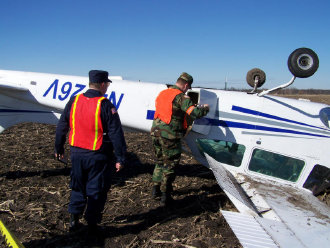Emergency Services

Civil Air Patrol covers several Emergency Services areas. The principal categories include search and rescue missions, disaster relief, humanitarian services, and Air Force support. Other services, such as homeland security and actions against drug-trafficking operations, are becoming increasingly important.
Civil Air Patrol is well-known for its search activities in conjunction with search and rescue (SAR) operations. CAP is involved with approximately three quarters of inland SAR missions directed by the United States Air Force Rescue Coordination Center at Tyndall Air Force Base, Florida. Outside of the continental United States, CAP directly supports the Joint Rescue Coordination Centers in Alaska, Hawaii, and Puerto Rico. CAP is credited with saving an average of 100 lives per year.
CAP is active in disaster relief operations, especially in Texas among other areas such as Florida, Mississippi and Louisiana that are frequently struck by hurricanes. CAP aircrews and ground personnel provide transportation for cargo and officials, aerial imagery to aid emergency managers in assessing damage, and donations of personnel and equipment to local, state and federal disaster relief organizations during times of need. In 2004, several hurricanes hit the southeast coast of the United States, with Florida being the worst damaged; CAP was instrumental in providing help to affected areas.
Civil Air Patrol conducts humanitarian service missions, usually in support of the Red Cross. CAP aircrews transport time-sensitive medical materials, including blood and human tissue, when other means of transportation (such as ambulances) are not practical or possible. Following the September 11 attacks on the World Trade Center in New York City when all general aviation was grounded, one of the first planes to fly over the destroyed World Trade Center was a CAP aircraft taking photographs.
CAP performs several missions that are not combat-related in support of the United States Air Force, including damage assessment, transportation of officials, communications support and low-altitude route surveys.
As a humanitarian service organization, CAP assists federal, state and local agencies in preparing for and responding to homeland security needs. In particular, the CAP fleet is used in training exercises to prepare USAF pilots to intercept enemy aircraft over the Continental United States. Civil Air Patrol aircraft are flown into restricted airspace, where Air Force F-16 Fighting Falcon and F-15 Eagle pilots may practice high-speed intercepts.
The Red Cross, Salvation Army and other civilian agencies frequently ask Civil Air Patrol aircraft to transport vital supplies including medical technicians, medication, and other vital supplies. They often rely on CAP to provide airlift and communications for disaster relief operations. CAP also assists the United States Coast Guard and Coast Guard Auxiliary.
Civil Air Patrol assists the U.S. Customs and Border Protection, Drug Enforcement Administration, and United States Forest Service in the War on Drugs. In 2005, CAP flew over 12,000 hours in support of this mission and led these agencies to the confiscation of illegal substances valued at over US$400 million. Civil Air Patrol makes extensive use of the Airborne Real-time Cueing Hyperspectral Enhanced Reconnaissance system, mounted on the Gippsland GA8 Airvan. The system is able to evaluate spectral signatures given off by certain objects, allowing the system to identify, for example, a possible marijuana crop.
The George H. W. Bush Composite Squadron also conducts non-mission flight operations using corporate Civil Air Patrol aircraft to maintain pilot proficiency and to provide cadet orientation flights.